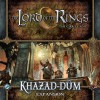profile badges
...
...
...
...
recent achievements

Rated 10 Games
Rate 10 games you have played.
Rate 10 games you have played.

Critic - Level 1
Earn Critic XP to level up by completing Critic Quests!
Earn Critic XP to level up by completing Critic Quests!

My First Game Tip
Submit a game tip, strategy, or house rule.
Submit a game tip, strategy, or house rule.

Rated 5 Games
Rate 5 games you have played.
Rate 5 games you have played.




































A Few Acres of Snow
The Designer of A Few Acres Of Snow isn’t shy in confessing that Dominion was his inspiration when creating the game. He saw the deckbuilding mechanic as a fascinating new idea, and resolved to use it to create a game with more depth and strategy. What he came up with is an interesting and clever 2-player conflict game which is novel and enjoyable but suffers from some flaws.
—
The background of the game is the Seven Years War between the British and the French – fighting over the North Eastern part of what we now call the United States and Canada. Both mighty empires had seen the potential in this vast new land, and were trying to exert their influence on it. Not easily done from across the Atlantic in the year 1760!
The game is played on a map board, which has an asymmetrical setup; the French are more established, the British richer and have slightly more Military. The board itself is attractive but suffers a little from style over functionality. Some rivers and roads on the map are not actually usable in play, which is confusing. Players will undoubtedly have moments where they find themselves debating if moves are legal or not, which suggests that the game perhaps wasn’t playtested across a wide enough audience of newbies.
The pieces are simple wooden discs and cubes which are uninspiring but perfectly functional. The art isn’t totally to my taste – colours are quite washed out in many pieces and there’s nothing to match the quality of the box cover – but it’s coherent and fits the theme. The rules are well laid out and overall clear and concise, although I did play my first ever game with some minor errors.
—
Each turn is simple in structure – you take two actions then draw up to five cards again. Each side is able to expand and develop their force on the board by playing combinations of cards from their hand. They can also purchase new cards from the supply using cash, and just like Dominion, when you draft a new card into your deck you can’t use it immediately – you need to wait until you have cycled your deck completely. This is meant to simulate the difficulties of supplying a conflict thousands of miles across the sea. Requests for more troops or cash could be very slow to arrive.
A key difference from Dominion is that at the end of your turn you do not discard any unused cards and draw a new hand – you simply ‘top up’ to the hand size of five. This causes real problems if you’re not careful with which cards you collect as your hand starts to fill up with junk that becomes very hard to shift. Expanding your empire is the main cause of this as you have to add that location’s card to your deck, and many of the villages you capture as stepping stones to other places have utterly worthless cards.
A major problem for new players is not understanding this and stalling in the middle of the game, with a poor deck and few ways to solve the issue. There is a ‘Chapel’ style card which allows you to thin your deck, but each player only has one of them and again, you need to buy it and wait for it to cycle into your hand before you can use it.
The other new mechanic which helps with this is the “Reserve” – an area to store up to 5 cards which you may need in the future, although you do have to pay to get them back again.
Another issue for new players is the seemingly huge list of actions you can take. The Player Aid offers perhaps 25 different options with key items like Expansion, Fortification, Raiding, Development, Trading Furs, Earning Gold, Besieging forts, Buying Cards and so on split into several minor choices – all of which can be overwhelming – particularly if you don’t know how the game pans out. After playing for a short time you realise that only perhaps 3 or 4 options are ever available to you at any time, based on your hand, and it becomes easier to manage.
—
A Few Acres Of Snow is a game which rewards multiple plays between the same two players, swapping sides frequently to work out the various tactics and strategies that each nation can use.
There is a steep learning curve which will put off casual gamers, and it’s not without its quirks. I also have a fear that with fixed starting cards, positions and decks, replayability will not be as high as you might like.
Even with all those criticisms, this is still a strong game which is very thematic and requires a great deal of thought and planning. I’d recommend it but only if you like good strategic depth, often play two player games, and your opponent is happy to spend the first game or two just working out the system. If you’re after instant gratification then look elsewhere.